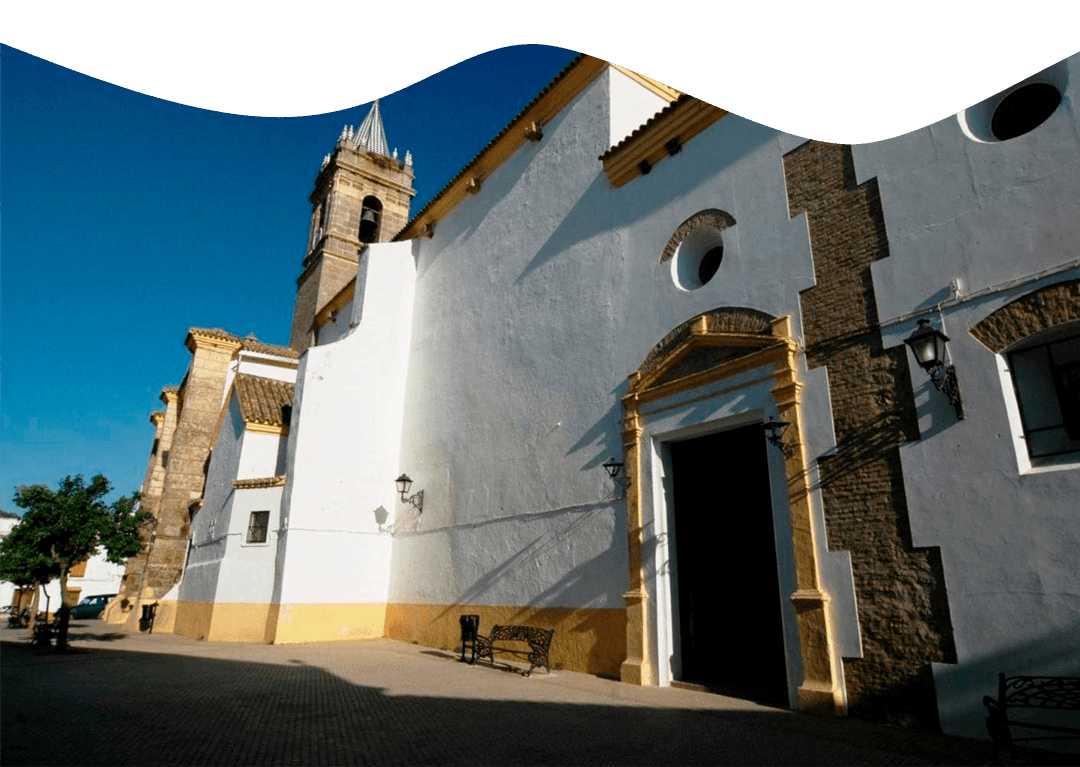



Haz clic en play AHORA
El origen de la Ermita se remonta a un documento que posee la Hermandad del 19 de marzo de 1484 en el que se indica que esta Ermita era un antiguo hospital, sede del Hospital de la Caridad de Sevilla.
La labor que aquí se realizaba, era exactamente la misma que en el Hospital de la Caridad de Sevilla, ayudando a los pobres, dando albergue a los peregrinos, igualmente se cuidaba de los enfermos y se daba sepultura a las personas que carecían de medios económicos para enterrar a sus familiares.
El edificio primitivo del Hospital era de estilo mudéjar y la extensión de los terrenos llegaban desde los aledaños de la parroquia y hasta finales de esta calle. Con el tiempo, el edificio fue reformándose en los siglos XIX y XX y los terrenos se vendieron hasta quedar tal como ha llegado a nuestros días.
La Hermandad conserva dos libros de reglas sumamente interesantes:
El primer libro es del 19 de octubre de 1727, cuando la Hermandad se llama de la “Vera Cruz”. No tenemos documentación de cuándo y por qué motivo se cambió el nombre al actual de la Misericordia.
El segundo libro de reglas es de nuestra refundación. Sabemos que hubo unos años de inactividad y fue en julio de 1952 cuando el párroco, Don Antonio Pastor Portillo, el jefe de estación Don José Muñoz Núñez y algunos hombres de nuestra localidad refundaron la Hermandad.
Le debemos mucho a todas aquellas personas pero principalmente a Don José Muñoz Núñez, ya que hizo mucho por darle difusión a la Hermandad, a todos los compañeros, (maquinistas, operarios o revisores) que trabajaban en la línea férrea de Mérida y pasaban por El Pedroso. Les hablaba con tanta pasión de su Hermandad que terminaban haciéndose hermanos.
En aquellos años, casi el 60% de la nómina de hermanos eran ferroviarios. Es por ello, que a nuestro Cristo se le conoce como el “Cristo de los ferroviarios“, aunque también se le conoce como el “Cristo del Hospital” por nuestro origen.

Haz clic en play AHORA
La Ermita tiene su entrada por la nave de la Epístola y es un edificio de planta rectangular con dos espacios diferenciados:
1.- La nave principal.
2.- La Capilla Mayor.
Ambos separados por un arco triunfal apuntado, como vestigio de la época mudéjar.
La Capilla Mayor tiene una bóveda vaída, también llamada bóveda de pañuelo y en ella se encuentran dos retablos con Nuestros Sagrados Titulares.
Justo de frente se encuentra el Santísimo Cristo de la Misericordia, una talla de finales del siglo XV. Se desconoce su autor, pero diversos estudios aseguran que es de escuela castellana. Es un Cristo con la cabeza baja, inclinada hacia su derecha, expresión propia de un crucificado ya fallecido. Se encuentra en un altar hornacina del siglo XVII con decoración de hojarasca.
En el retablo puedes ver atributos de la Pasión de Nuestro Señor, y a ambos lados de la cruz las escaleras negras que utilizaron para desenclavarlo de la cruz y realizar el descendimiento.
Sobre la escalera de la derecha está el gallo relativo a las negaciones de San Pedro y justo arriba de la escalera de la izquierda la túnica que portaba Nuestro Señor antes de su crucifixión.

Haz clic en play AHORA
En el lado izquierdo puedes ver el retablo hornacina de Nuestra Señora de los Dolores, una talla de vestir del siglo XVIII de autor desconocido, dentro de un altar adornado con estípites, que son las columnas que lo adornan a ambos lados de la Virgen, parecen como triángulos invertidos que van decreciendo en tamaño a medida que se acercan al capitel. Nuestra Señora de los Dolores, está vestida según el calendario litúrgico y la época del año en la que nos encontremos.

Haz clic en play AHORA
En el interior de la Ermita, puedes encontrar otras obras como una escultura del niño Jesús de finales del siglo XVII y una serie de lienzos que tienen como temática la representación del Ecce Homo, la Virgen María y la Inmaculada.
Esta pequeña Ermita está situada a escasos metros de la Iglesia de Nuestra Señora de la Consolación, desde donde procesionan el Viernes Santo la cofradía de igual nombre a los sagrados titulares: el Santísimo Cristo de la Misericordia y Nuestra Señora de los Dolores.
We firmly believe that the internet should be available and accessible to anyone, and are committed to providing a website that is accessible to the widest possible audience, regardless of circumstance and ability.
To fulfill this, we aim to adhere as strictly as possible to the World Wide Web Consortium’s (W3C) Web Content Accessibility Guidelines 2.1 (WCAG 2.1) at the AA level. These guidelines explain how to make web content accessible to people with a wide array of disabilities. Complying with those guidelines helps us ensure that the website is accessible to all people: blind people, people with motor impairments, visual impairment, cognitive disabilities, and more.
This website utilizes various technologies that are meant to make it as accessible as possible at all times. We utilize an accessibility interface that allows persons with specific disabilities to adjust the website’s UI (user interface) and design it to their personal needs.
Additionally, the website utilizes an AI-based application that runs in the background and optimizes its accessibility level constantly. This application remediates the website’s HTML, adapts Its functionality and behavior for screen-readers used by the blind users, and for keyboard functions used by individuals with motor impairments.
If you’ve found a malfunction or have ideas for improvement, we’ll be happy to hear from you. You can reach out to the website’s operators by using the following email
Our website implements the ARIA attributes (Accessible Rich Internet Applications) technique, alongside various different behavioral changes, to ensure blind users visiting with screen-readers are able to read, comprehend, and enjoy the website’s functions. As soon as a user with a screen-reader enters your site, they immediately receive a prompt to enter the Screen-Reader Profile so they can browse and operate your site effectively. Here’s how our website covers some of the most important screen-reader requirements, alongside console screenshots of code examples:
Screen-reader optimization: we run a background process that learns the website’s components from top to bottom, to ensure ongoing compliance even when updating the website. In this process, we provide screen-readers with meaningful data using the ARIA set of attributes. For example, we provide accurate form labels; descriptions for actionable icons (social media icons, search icons, cart icons, etc.); validation guidance for form inputs; element roles such as buttons, menus, modal dialogues (popups), and others. Additionally, the background process scans all of the website’s images and provides an accurate and meaningful image-object-recognition-based description as an ALT (alternate text) tag for images that are not described. It will also extract texts that are embedded within the image, using an OCR (optical character recognition) technology. To turn on screen-reader adjustments at any time, users need only to press the Alt+1 keyboard combination. Screen-reader users also get automatic announcements to turn the Screen-reader mode on as soon as they enter the website.
These adjustments are compatible with all popular screen readers, including JAWS and NVDA.
Keyboard navigation optimization: The background process also adjusts the website’s HTML, and adds various behaviors using JavaScript code to make the website operable by the keyboard. This includes the ability to navigate the website using the Tab and Shift+Tab keys, operate dropdowns with the arrow keys, close them with Esc, trigger buttons and links using the Enter key, navigate between radio and checkbox elements using the arrow keys, and fill them in with the Spacebar or Enter key.Additionally, keyboard users will find quick-navigation and content-skip menus, available at any time by clicking Alt+1, or as the first elements of the site while navigating with the keyboard. The background process also handles triggered popups by moving the keyboard focus towards them as soon as they appear, and not allow the focus drift outside of it.
Users can also use shortcuts such as “M” (menus), “H” (headings), “F” (forms), “B” (buttons), and “G” (graphics) to jump to specific elements.
We aim to support the widest array of browsers and assistive technologies as possible, so our users can choose the best fitting tools for them, with as few limitations as possible. Therefore, we have worked very hard to be able to support all major systems that comprise over 95% of the user market share including Google Chrome, Mozilla Firefox, Apple Safari, Opera and Microsoft Edge, JAWS and NVDA (screen readers), both for Windows and for MAC users.
Despite our very best efforts to allow anybody to adjust the website to their needs, there may still be pages or sections that are not fully accessible, are in the process of becoming accessible, or are lacking an adequate technological solution to make them accessible. Still, we are continually improving our accessibility, adding, updating and improving its options and features, and developing and adopting new technologies. All this is meant to reach the optimal level of accessibility, following technological advancements. For any assistance, please reach out to